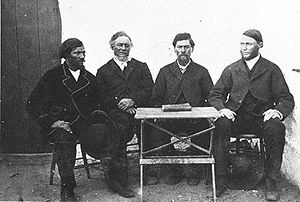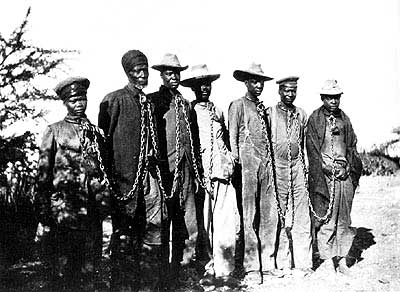 From 1884, Namibia was a German colony: German
South-West Africa. After the First World War, the League
of Nations mandated South Africa to administer the territory. Following World War II, the League of Nations
was dissolved in April 1946 and its successor, the United Nations, instituted a Trusteeship system to bring all
of the former German colonies in Africa under UN control. South Africa objected
arguing that a majority of the territory's people were content with South
African rule.
From 1884, Namibia was a German colony: German
South-West Africa. After the First World War, the League
of Nations mandated South Africa to administer the territory. Following World War II, the League of Nations
was dissolved in April 1946 and its successor, the United Nations, instituted a Trusteeship system to bring all
of the former German colonies in Africa under UN control. South Africa objected
arguing that a majority of the territory's people were content with South
African rule. Legal argument ensued over the course of the next twenty years until, in
October 1966, the UN General
Assembly decided to end the mandate, declaring that South Africa had no
other right to administer the territory and that henceforth South-West Africa
was to come under the direct responsibility of the UN (Resolution 2145 XXI of 27
October 1966).
Legal argument ensued over the course of the next twenty years until, in
October 1966, the UN General
Assembly decided to end the mandate, declaring that South Africa had no
other right to administer the territory and that henceforth South-West Africa
was to come under the direct responsibility of the UN (Resolution 2145 XXI of 27
October 1966).Bantu immigration - the Herero
During the 17th century the Herero, a pastoral, nomadic people keeping cattle, moved into Namibia. They came from the east African lakes and entered Namibia from the northwest. First they resided in Kaokoland, but in the middle of the 19th century some tribes moved further south and into Damaraland. A number of tribes remained in Kaokoland: these were the Himba people, who are still there today. The Herero were said to have enslaved certain groups and displaced others such as the Bushmen to marginal areas unsuitable for their way of life.The Oorlams
In the 19th century white farmers, mostly Boers moved farther northwards pushing the indigenous Khoisan peoples, who put up a fierce resistance, across the Orange River. Known as Oorlams, these Khoisan adopted Boer customs and spoke a language similar to Afrikaans. Armed with guns, the Oorlams caused instability as more and more came to settle in Namaqualand and eventually conflict arose between them and the Nama. Under the leadership of Jonker Afrikaner, the Oorlams used their superior weapons to take control of the best grazing land. In the 1830s Jonker Afrikaner concluded an agreement with the Nama chief Oaseb whereby the Oorlams would protect the central grasslands of Namibia from the Herero who were then pushing southwards. In return Jonker Afrikaner was recognised as overlord, received tribute from the Nama and settled at what today is Windhoek, on the borders of Herero territory. The Afrikaners soon came in conflict with the Herero who entered Damaraland from the south at about the same time as the Afrikaner started to expand farther north from Namaqualand. Both the Herero and the Afrikaner wanted to use the grasslands of Damaraland for their herds. This resulted in warfare between the Herero and the Oorlams as well as between the two of them and the Damara, who were the original inhabitants of the area. The Damara were displaced by the fighting and many were killed.With their horses and guns, the Afrikaners proved to be militarily superior and forced the Herero to give them cattle as tribute.
Baster immigration
The last group to arrive in Namibia before the Europeans were the Basters – descendants of Boer men and African women (mostly Nama). Being Calvinist and Afrikaans-speaking, they considered themselves to be culturally more "white" than "black". As with the Oorlams, they were forced northwards by the expansion of white settlers when, in 1868, a group of about 90 families crossed the Orange River into Namibia. The Basters settled in central Namibia, where they founded the city Rehoboth. In 1872 they founded the "Free Republic of Rehoboth" and adopted a constitution stating that the nation should be led by a "Kaptein" directly elected by the people, and that there should be a small parliament, or Volkraad, consisting of three directly-elected citizens.
European influence and colonisation
The first European to set foot on Namibian soil was the Portuguese Diogo Cão in 1485, who stopped briefly on the Skeleton Coast, and raised a limestone cross there, on his exploratory mission along the west coast of Africa.The next European to visit Namibia was also a Portuguese, Bartholomeu Dias, who stopped at what today is Walvis Bay and Lüderitz (which he named Angra Pequena) on his way to round the Cape of Good Hope.
The inhospitable Namib Desert constituted a formidable barrier and neither of the Portuguese explorers went far inland.
In 1793 the Dutch authority in the Cape decided to take control of Walvis bay, since it was the only good deep-water harbour along the Skeleton Coast. When the United Kingdom took control of the Cape Colony in 1797, they also took over Walvis Bay. But white settlement in the area was limited, and neither the Dutch nor the British penetrated far into the country.
One of the first European groups to show interest in Namibia were the missionaries. In 1805 the London Missionary Society began working in Namibia, moving north from the Cape Colony. In 1811 they founded the town Bethanie in southern Namibia, where they built a church, which today is Namibia's oldest building.
In the 1840s the German Rhenish Mission Society started working in Namibia and co-operating with the London Missionary Society. It was not until the 19th century, when European powers sought to carve up the African continent between them in the so-called "Scramble for Africa", that Europeans – Germany and Great Britain in the forefront – became interested in Namibia.
The first territorial claim on a part of Namibia came when Britain occupied Walvis Bay, confirming the settlement of 1797, and permitted the Cape Colony to annex it in 1878. The annexation was an attempt to forestall German ambitions in the area, and it also guaranteed control of the good deepwater harbour on the way to the Cape Colony and other British colonies on Africa's east coast.
A region, the Caprivi Strip, became a part of German South West Africa after the Heligoland-Zanzibar Treaty on 1 July 1890, between the United Kingdom and Germany. The Caprivi Strip in Namibia gave Germany access to the Zambezi River and thereby to German colonies in East Africa. In exchange for the island of Heligoland in the North Sea, Britain took control of the island of Zanzibar in East Africa.
German South-West Africa
Soon after declaring Lüderitz and a vast area along the atlantic coast a German protectorate, German troops were deployed as conflicts with the native tribes flared up, most significantly with the Namaqua. Under the leadership of the tribal chief Hendrik Witbooi, the Namaqua put up a fierce resistance to the German occupation. Contemporary media called the conflict "The Hottentot Uprising".The Namaqua's resistance proved to be unsuccessful, however, and in 1894 Witbooi was forced to sign a "protection treaty" with the Germans. The treaty allowed the Namaqua to keep their arms, and Witbooi was released having given his word of honour not to continue with the Hottentot uprising.
In 1894 major Theodor Leutwein was appointed governor of German South-West Africa. He tried without great success to apply the principle of "colonialism without bloodshed". The protection treaty did have the effect of stabilising the situation but pockets of rebellion persisted, and were put down by an elite German regiment Schutztruppe, while real peace was never achieved between the colonialists and the natives.
Being the only German colony considered suitable for white settlement at the time, Namibia attracted a large influx of German settlers. In 1903 there were 3,700 Germans living in the area, and by 1910 their number had increased to 13,000. Another reason for German settlement was the discovery of diamonds in 1908. Diamond production continues to be a very important part of Namibia's economy.
The settlers were encouraged by the government to appropriate land from the natives, and forced labour – hard to distinguish from slavery – was used. As a result, relations between the German settlers and the natives deteriorated.
The Herero and Namaqua wars
The ongoing local rebellions escalated in 1904 into the Herero and Namaqua Wars when the Herero attacked remote farms on the countryside, killing approximately 150 Germans.
The outbreak of rebellion was considered to be a result of Theodor Leutwein's softer tactics, and he was replaced by the more notorious General Lothar von Trotha.In the beginning of the war the Herero, under the leadership of chief Samuel Maharero had the upper hand. With good knowledge of the terrain they had little problem in defending themselves against the Schutztruppe (initially numbering only 766). Soon the Namaqua people joined the war, again under the leadership of Hendrik Witbooi.
Descendants of Lothar von Trotha apologized to six chiefs of Herero royal houses for the actions of their ancestor on 7 October 2007.
South African rule
In 1915, during World War I, South Africa, being a member of the British Commonwealth and a former British colony, occupied the German colony of South-West Africa.In February 1917, Mandume Ya Ndemufayo, the last king of the Kwanyama of Ovamboland, was killed in a joint attack by South African forces for resisting South African sovereignty over his people.
On 17 December 1920, South Africa undertook administration of South-West Africa under the terms of Article 22 of the Covenant of the League of Nations and a Class C Mandate agreement by the League Council. The Class C mandate, supposed to be used for the least developed territories, gave South Africa full power of administration and legislation over the territory, but required that South Africa promote the material and moral well-being and social progress of the people.
Following the League's supersession by the United Nations in 1946, South Africa refused to surrender its earlier mandate to be replaced by a United Nations Trusteeship agreement, requiring closer international monitoring of the territory's administration. Although the South African government wanted to incorporate "South-West Africa" into its territory, it never officially did so, although it was administered as the de facto 'fifth province', with the white minority having representation in the whites-only Parliament of South Africa. In 1959, the colonial forces in Windhoek sought to remove black residents further away from the white area of town. The residents protested and the subsequent killing of eleven protesters spawned by the Namibian War of Independence with the formation of united black opposition to South African rule as well as the township of Katutura.
During the 1960s, as the European powers granted independence to their colonies and trust territories in Africa, pressure mounted on South Africa to do so in Namibia, which was then South-West Africa. On the dismissal (1966) by the International Court of Justice of a complaint brought by Ethiopia and Liberia against South Africa's continued presence in the territory, the U.N. General Assembly revoked South Africa's mandate.







